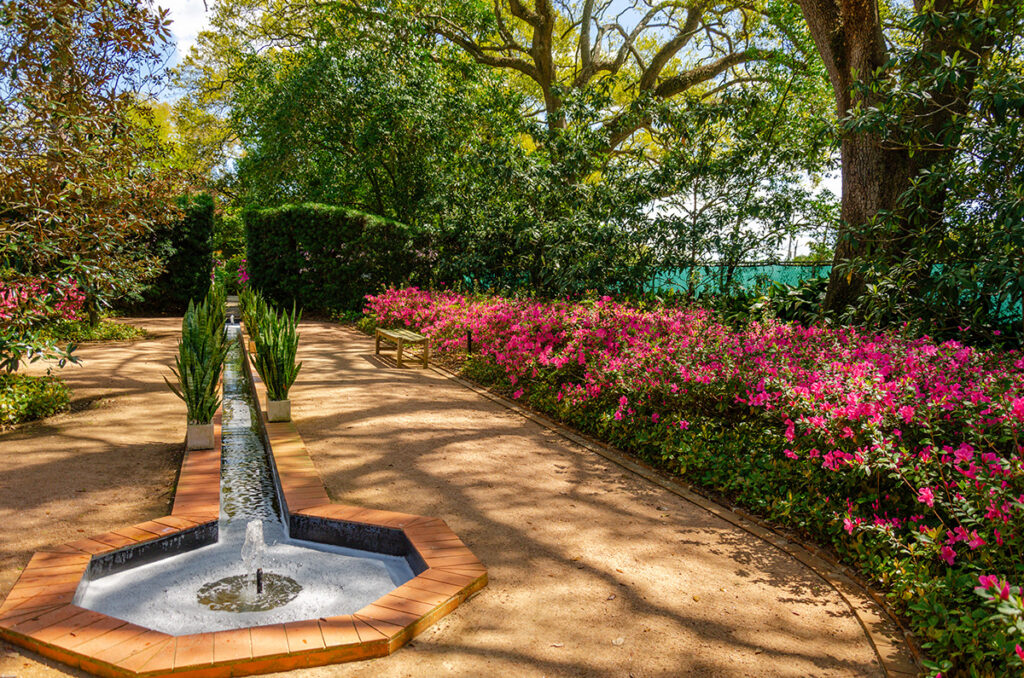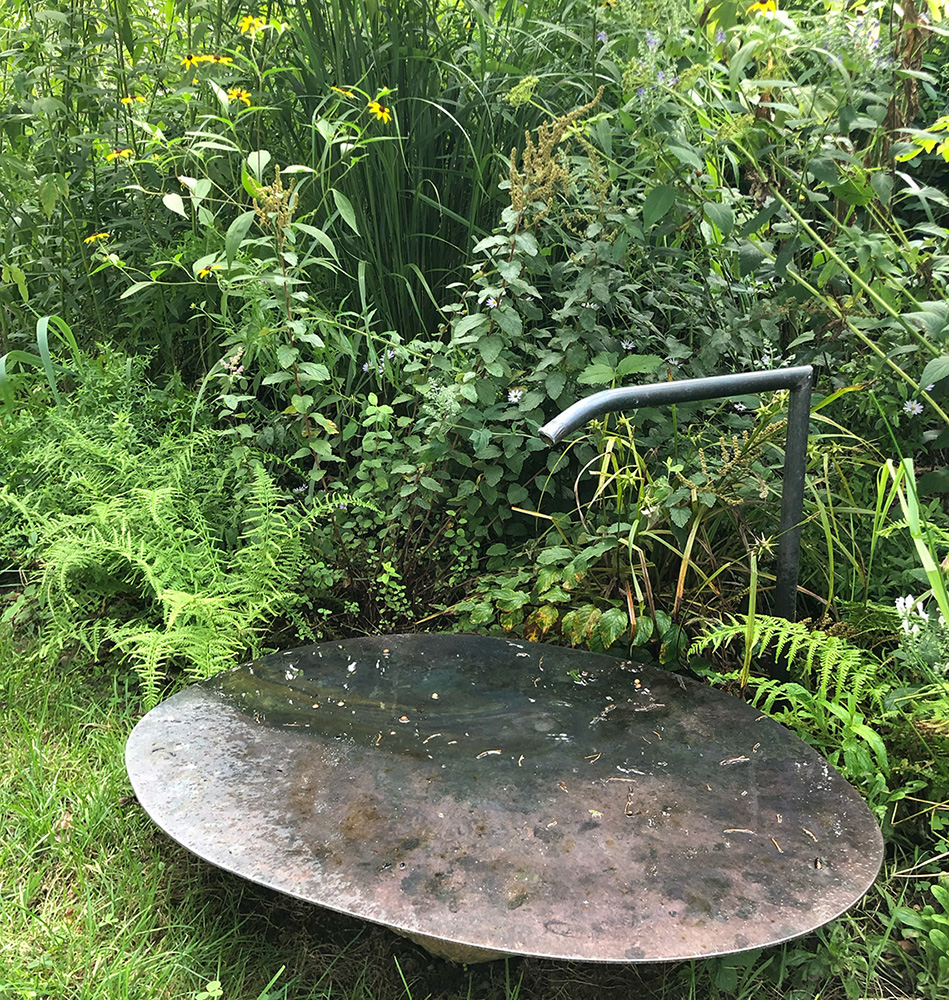
Photographs by Diego Bernal for Longue Vue, unless otherwise noted.
It can get hot in New Orleans, really hot—and really humid. Climate change can cause drought one month, followed by floods the next. Then there are insect and disease pressures, infestations of invasive plants, frequent epic storms. What’s a historic garden to do? Longue Vue, Perfect Earth Project’s newest Pathways to PRFCT partner, is trying to stay ahead by being proactive with care. They have become a model of sustainability.
The designated National Historic Landmark, designed by pioneering landscape architect Ellen Biddle Shipman in the early 20th century, committed to being toxic-free—no chemical pesticides, herbicides, fungicides or fertilizers—in 2020. They have banned leaf blowers. They have almost entirely converted from gas-powered equipment to electric (and hope to be 100% electric by next year). They leave as much biomass on the property as possible. And they have a dedicated Integrated Plant Care Gardener (What a great title!), Simeon Benjamin, who holistically tends to the garden organically. He shares with us how he approaches keeping Longue Vue beautiful, healthy, and toxic-free and what you too can do in your own yards.
1. Inspect Your Garden.
“Get to know your plants,” says Benjamin. And not just what conditions a plant needs, like hours of sun or water requirements, but also what pests it might be susceptible to. “This way you’ll know what to be on the lookout for, says Benjamin. He starts each day walking through the garden with keen eyes. For home gardeners, he suggests doing this once every week or two, taking notes to keep track of any changes you might see. Look for anything out of the ordinary like yellowing, brown, or dead leaves, or white powder dusting the foliage. “And don’t forget to look underneath the leaves,” reminds Benjamin. “Many pests like to hide under there.”
In the Wild Garden, which contains native planting selections by Caroline Dorman, oak leaf hydrangea, Texas star hibiscus, ironweed, and a variety of ferns, flourish. “Native plants have fewer pest issues, require less water, and are easier to maintain than the non-native plants,” says Benjamin.

2. Be Patient.
When Benjamin spots something out of the ordinary, he begins with a wait and see approach. “I research the plant to see what pest it could be if I can’t easily identify it,” he says. If a home gardener can’t figure out the problem, he suggests contacting your local cooperative extension to help with the diagnoses. (In Louisiana, Benjamin recommends LSU AgCenter Agent or The Plant Diagnostic Center). “I then monitor the plant each and every week to see if the damage level is enough for me to take action or if something like a ladybug or lacewing, will turn up and take care of it for me,” he says.
When it comes to action, he’ll start with the least aggressive approach and work his way up as necessary. He’ll remove pests like aphids physically with his hands. Or when the tea scale infests a camellia, for example, he’ll use a hose to remove them or clip off heavily damaged branches to prevent spread. If all else fails, he will apply Ferti-lome or All Seasons Horticultural oil judiciously to the area, and only in the early morning since sun and oil will cause the plant to burn. Everything is done in moderation. If nothing fixes the problem, like a pervasive root rot, he’ll remove the affected plants, solarize the soil by covering the area with plastic for weeks, and start afresh, bringing in new soil and feeding it with nutrients and microorganisms.
3. Raise an Insect Task Force.
When you court pollinators, you’re also creating a powerful insect army right on your property. “We have a pollinator garden and lots of native plants around the property,” says Benjamin. “Together, they create a welcoming biodiverse home with food and shelter for beneficial insects.” Ladybugs and assassin bugs devour aphids. Non-stinging parasitic wasps, which are attracted to plants with tiny, nectar-rich flowers and herbs, target cutworms and mealybugs. When Benjamin sees insects like these in action, he lets them handle the job. “I love that we are growing a site-wide biological control.”.

The Pollinator Garden flaunts a spectacular display of native wildflowers, including Rudbeckia, salvia, bee balm, Coreopsis grandiflora, Gaillardia pulchella, partridge pea. In addition to attracting butterflies and bees, it also lures beneficial insects to the landscape, which can help handle pests. Photograph courtesy of Longue Vue.
4. Be Proactive.
Benjamin and his team are careful to stay on top of pernicious weeds. In the Wild Garden, for instance, staff and volunteers focus weekly on “hotspots” of bushkiller (Cayratia japonica), a vine that has taken over large areas there. They pull it out by hand and cut it to the ground with a string trimmer. (Repeated cutting to the ground will prevent photosynthesis, eventually weakening it.) The team recently noticed in areas where a native grass called basketgrass (Oplismenus hirtellus), which they had previously pulled out because they were unfamiliar with it, is growing, they have fewer instances of bushkiller. They now encourage basketgrass to grow. In larger areas with aggressive weeds where hand pulling is too time consuming, they’ll lay down plastic for about eight weeks (in summer the temperatures in Louisiana can be steadily above 90 degrees) to smother plants.
Benjamin scouts the Walled Garden, which contains an array of edible and medicinal plants like rosemary, anise hyssop, tulsi, celosia, okra, peppers, and hibiscus, weekly to look for pests. “This is where I often find a biological control like ladybugs or assassin beetles taking care of aphids,” says Benjamin. This garden also features Muscadine Grape vines, small fruiting Kumquat trees, and irises. It was originally the kitchen garden of the Stern family, who lived at Longue Vue and commissioned Biddle Shipman to design the gardens.

5. Be Tidy. (But Not Too Tidy!)
In the fall, Benjamin is careful to rake leaves off hardscapes, the lawns, and in areas where they might pile up too thickly and suffocate or rot plants. But he doesn’t discard them. He simply moves them to another spot in the garden, like the compost area, to give any overwintering bumble bees, leafcutter and mason bees, luna moths, fireflies, and other beneficial bugs a safe habitat. Longue Vue invites volunteers to participate in Rake Day every September 19. They launched this program six years ago to encourage the community to stop using leaf blowers, reduce pollution and support the ecosystem.

Azaleas can be prone to lace bugs, a pest that sucks chlorophyll from the leaves. “Leaf drop and white speckling on leaves is a tell-tale sign,” says Benjamin. He keeps the azaleas, like the ones you see here in the Canal Garden, well-fed with molasses and seaweed, applying the organic nutrients every two weeks in summer to prevent lace bugs and other pests from attacking.
6. Prioritize Prevention.
“A lot of pests attack plants when they are weak and have poor nutrient care,” says Benjamin. “Healthy plants have resistance and will fight back.” Since this historic garden includes an array of plants from all over the world with various cultural needs, Benjamin and the horticultural team have to be more hands-on with care to help them thrive in Southern Louisiana’s climate. (The Louisiana native plants growing in the garden, on the other hand, require much less effort from the gardeners and are also less susceptible to pests.) To make sure the historic, non-native plants and trees stay healthy, Benjamin feeds the soil with compost and regular applications of organic seaweed and molasses from MicroLife, an organic biological fertilizer company. “They have a high nutrient content and feed the microorganisms in the soil,” he says of these fertilizers. Since he’s been applying these nutrients regularly to plants like camellias, azaleas, and citrus, he’s seen fewer instances of pests and disease. He also applies a monthly foliar microorganism treatment called Liquid AF, also from MicroLife, from May to October, which acts as a protection against pathogens, like powdery mildew.
The Portico Garden showcases mixed colorful borders and lush plantings, including historic plants like phlox, salvia, gomphrena, snapdragons, lilies, poppies, baby’s breath, and alyssum. This formal room also features a pair of espalier Magnolia grandiflora ‘Little Gems’ and matching Osmanthus fragrans in the curved niches of the stairs, as well as native Carolina jasmine vines.

By Melissa Ozawa
This is part of a series with Gardenista, which ran on November 14, 2024.









